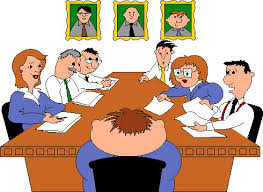Purpose:
Plan
meetings with purpose. Define the
purpose or objective of the meeting
Participant:
Determine
the people who need to attend this meeting to accomplish the purpose. Structure the meeting and be organized to best
accomplish the purpose and it should have the greatest impact on the
participants to attain the meeting objective.
Location and Time
Select
a meeting place that best matches the participant's needs, objective, and the
meeting structure. Give consideration to
size, comfort, accessibility, adequate parking, room acoustics, equipment
needs, etc. Choose a meeting time base
on the availability of participants and meeting facilities. The anticipated length of the meeting should
also be a factor in deciding when to schedule the meeting.
Agenda
Prepare
a meeting agenda and distribute to participants at least three days prior to
the meeting day. An agenda is crucial to
meeting success in three ways:
·
clarifies the
objectives so people understand the meeting purpose and tasks;
·
helps participants
plan and prepare to make an effective contribution; and
·
provides direction
and focus for the discussion.
There
are a variety of agenda styles but essentially they should contain at least the
following elements:
·
title (e.g.,
evaluation review meeting),
·
time (e.g.
8:00-10:00 a.m.)
·
date,
·
location,
·
discussion items,
and
·
names of persons
responsible for covering each item.
Some
people prefer to include time allotments for each agenda item to improve
meeting effectiveness s (e.g. review minutes 1:05-1:10).
Responsibilities
There
should be a mutual understanding of not only the meeting purpose, but also
individual assignments and how they fit into the total program. Meetings that are more focused on brainstorming
or creativity may require little or no individual assignments. In task-oriented or policy deciding meetings,
it is best to prepare a written summary of assigned duties so individuals know
what their responsibility is for the meeting.
Confirmation
If it
is a first meeting or if the meeting is on a new day or time, individually
contact all participants a week to three days before the meeting day. Contact can be as simple as sending everyone a
friendly reminder through office e-mail, phone calls, or a post card reminder
through the mail. For regularly scheduled
meetings, choose a location and meeting time and try not to change it.
RUN EFFECTIVE MEETINGS
- Begin on time and end on time
Starting a meeting late sends the message that it's okay
to be late and it shows a lack of respect and appreciation for those who make
the effort to arrive on time. If you
begin a meeting five to seven minutes after it was scheduled, you are starting
late. Some people may have back-to-back
meetings.
Ending on time shows respect for participants valuable
time. However, no one ever complains if
you are fortunate enough to end early.
- Use the Agenda
Review the agenda with participants at the beginning of
the meeting. Continually refer back to the agenda throughout the meeting to
keep discussion centred on the stated purpose and specified agenda items.
- Use an Ideas Bin
A "bin" consists of blank sheet s (one or two)
torn from an easel pad and taped to the wall. The bin serves two valuable purposes:
- stores valuable ideas for consideration at an appropriate and convenient time, and
- allows discussion to stay focused on the agenda topic.
Using
the bin is an effective way to keep discussion focused and it helps people hold
onto their thoughts and ideas without being disruptive to the meeting.
- Establish and Use Ground Rules
Ground rules are explicit rules that the group agrees to
follow to help them facilitate productive discussions. The ground rules should be written down. Ground rules lay out the expectations of
"the way things should be done at meetings." Ground rules are used to facilitate group
interaction, not to restrict it. The
group can change the ground rules or add new ones based on group needs.
Examples of some typically used ground rules include:
- arrive and start on time;
- stick to the agenda;
- everyone participates;
- be realistic when accepting follow-up tasks;
- focus on interests, not positions;
- separate people from the problem;
- respect different viewpoints;
- share responsibility for following the ground rules.
- Control dominating individuals
Make sure each individual has a fair chance of expressing
ideas and opinions. Do not let one
person dominate the discussion. Ensure
that quiet participants are expressing their ideas and opinions.
§ Bring Food
Food energizes and motivates people more effectively than
any other meeting tactic. Although many
people still prefer the standard coffee and donuts, alternatives such as fruit,
juice, and bran muffins can be provided.
§ Summarize
Conclude the meeting by summarizing the discussion,
decisions made, tasks delegated, deadlines, and any action required by
participants. Include in the summary any
review plans for follow-up or the need to schedule any succeeding meetings. It is far easier to schedule the next meeting
while everyone is at the table then it is to wait and contact each participant
individually.
Shared from:
Marlene K. Rebori, Community and Organizational
Development SpecialistHOW TO ORGANIZE AND RUN EFFECTIVE MEETINGS, http://www.unce.unr.edu/publications/files/cd/other/fs9729.pdf

No comments:
Post a Comment